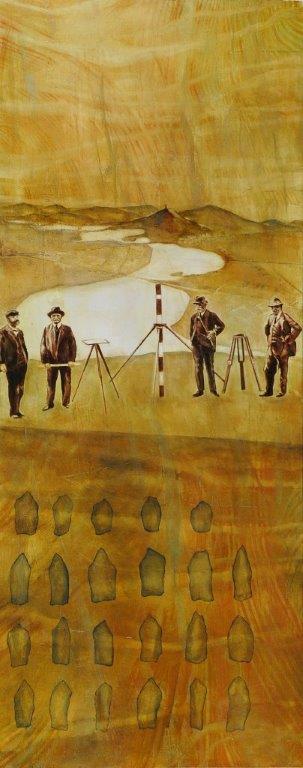Lakeshore Series
Written by Jono Lineen
New Works From Helen Tiernan
Helen Tiernan’s new body of work is inspired by beauty, landscape, her heritage and the connection between things lost but not forgotten such as Aboriginal land management and traditional Western interior decoration. The aesthetic link between these disparate ideas is the patterning they have left on the environment and in ourselves and it is to these designs that Helen returns to again and again in her recent paintings.
Bill Gammage’s groundbreaking work, The Biggest Estate on Earth – How Aborigines made Australia was an early motivation for the series. The paintings, like the book, explore the contrasting ways our ancient continent has been viewed and managed by ‘new comers’ and First Australians and how that practice has affected the people involved in it. As Gammage says in relation to Aboriginal land management, “… this was no haphazard mosaic making, but a planned, precise, fine-grained local caring.”
Fire, grass, kangaroos, the forest’s edge and human endeavour are focal points in Indigenous and non-Indigenous land management and the disparity in understanding between these elements and practices reveals the space between black and white conceptions of this continent. It is the patterning of these components that have become the focus of Helen’s new work.
This patterning is most evident in the environmental mosaics generated by the controlled distribution of cool and hot fires employed to optimize Aboriginal country. The Australian indigenous vision of beauty in landscape was related to the complex fire-shaped balance between species habitat, resource abundance and reduction of dangerous fuel loads. This contrasts with the Western, one-dimensional land management which views environment in terms of production, recreation, wilderness or some similar metric, but rarely blends functions. It is the tension between these two imaginings that lends Helen’s paintings the edge that makes them unforgettable.
In the friction is brilliance and Helen uncovers the beauty in Western design ideals, because she relates aboriginal understanding of beauty in the land to western ideas of beauty in the household. For early settlers home was inside, their houses were the space they could control while for Aboriginals home was outside, in country. At home both peoples desired beauty. Beauty for a westerner could have been in wallpaper, doilies or the pressed metal ceilings they invested in. It was something valued, similar to the gold edging Helen applies to her paintings. Many early wallpapers were scenes of new and recently explored lands – they were idyllic scenes, visionary interpretations of perfectly patterned worlds. The doilies and tin ceiling designs embossing Tiernan’s works are the blueprints of balance, reinforcing the idea that symmetry could be created inside a house through the use of objects.
Balance, beauty, home – these universal concerns link and inspire Helen’s work creating a collection that is memorable and inspirational. Beauty is timeless. Perhaps we can’t see the effects of aboriginal land management today. Rarely now do we see a scenic wallpaper but these elements still exist subconsciously all around us. Helen’s paintings reference that subliminal beauty, lost but not forgotten.
Jono Lineen, Curator, National Museum of Australia

